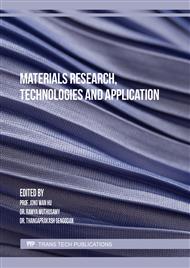[1]
Z. Shen, X. Xu, S. Xu, and D. Sun. A comparative study of land development patterns and regional thermal environments (RTEs) in typical urban agglomerations of China and America: A case study of Beijing-Tianjin-Hebei (BTH) and Boswash. Sci. Total Environ. Vol. 803, (2022), 149735. doi: https://doi.org/10.1016/j.scitotenv.2021.149735.
DOI: 10.1016/j.scitotenv.2021.149735
Google Scholar
[2]
M.Y. Joshi and J.Teller. Urban integration of green roofs: Current challenges and perspectives. Sustainability. Vol. 13, (2021), 12378. doi: https://doi.org/10.3390/su132212378.
DOI: 10.3390/su132212378
Google Scholar
[3]
J. Wang, A. Garg, S. Huang, G. Mei, J. Liu, K. Zhang, and L. Gan. The rainwater retention mechanisms in extensive green roofs with ten different structural configurations. Water Sci. Technol.. Vol. 84(8), (2021), 1839. doi: https://doi.org/10.2166/wst.2021.413.
DOI: 10.2166/wst.2021.413
Google Scholar
[4]
S.N. Ma'bdeh, H.H. Ali, and I.O. Rabab'ah. Sustainable assessment of using green roofs in hot-arid areas – Residential buildings in Jordan. J. Build. Eng. Vol. 45, (2022), 103559. doi: https://doi.org/10.1016/j.jobe.2021.103559.
DOI: 10.1016/j.jobe.2021.103559
Google Scholar
[5]
K. McConnell, C.V. Braneon, E. Glenn, N. Stamler, E. Mallen, D.P. Johnson, R. Pandya, J. Abramowitz, G. Fernandez, and C. Rosenzweig. A quasi-experimental approach for evaluating the heat mitigation effects of green roofs in Chicago, Illinois. Sustain. Cities Soc. Vol. 76, (2022), 103376. doi: https://doi.org/10.1016/j.scs.2021.103376.
DOI: 10.1016/j.scs.2021.103376
Google Scholar
[6]
P. Stella and E. Personne. Effects of conventional, extensive and semi-intensive green roofs on buildings conductive heat fluxes and surface temperatures in winter in Paris. Build. Environ. Vol. 205, (2021), 108202. doi: https://doi.org/10.1016/j.buildenv.2021.108202.
DOI: 10.1016/j.buildenv.2021.108202
Google Scholar
[7]
E. Jamei, H.W. Chau, M. Seyedmahmoudian, and A. Stojcevski. Review on the cooling potential of green roofs in different climates. Sci. Total Environ. Vol. 791, (2021), 148407. doi: https://doi.org/10.1016/j.scitotenv.2021.148407.
DOI: 10.1016/j.scitotenv.2021.148407
Google Scholar
[8]
M. Lin, J. Dong, L. Jones, J. Liu, T. Lin, J. Zuo, H. Ye, G. Zhang, and T. Zhou. Modeling green roofs' cooling effect in high-density urban areas based on law diminishing marginal utility of the cooling efficiency: A case study of Xiamen Island, China. J. Clean. Prod. Vol. 316, (2021), 128277. doi: https://doi.org/10.1016/j.jclepro.2021.128277.
DOI: 10.1016/j.jclepro.2021.128277
Google Scholar
[9]
M. Kazemi, L. Courard, and J. Hubert. Coarse recycled materials for the drainage and substrate layers of green roof system in dry condition: Parametric study and thermal heat transfer. J. Build. Eng. Vol. 45, (2022), 103487. doi: https://doi.org/10.1016/j.jobe.2021.103487.
DOI: 10.1016/j.jobe.2021.103487
Google Scholar
[10]
M. Yang, W. Dong, R. Cheng, H. Eang, Z. Zhao, F. Wang, and Y. Wang. Effect of highly efficient substrate modifier, super-absorbent polymer, on the performance of the green roof. Sci. Total Environ. Vol. 806, (2022), 150638. doi: https://doi.org/10.1016/j.scitotenv.2021.150638.
DOI: 10.1016/j.scitotenv.2021.150638
Google Scholar
[11]
E.I.F. Wooster, R. Fleck, F. Torpy, D. Ramp, and P.J. Irga. Urban green roofs promote metropolitan biodiversity: A comparative case sudy. Build. Environ. Vol. 207, (2022), 108458. doi: https://doi.org/10.1016/j.buildenv.2021.108458.
DOI: 10.1016/j.buildenv.2021.108458
Google Scholar
[12]
P. Bevilacqua. The effectiveness of green roofs in reducing building energy consumptions across different climates. A summary of literature results. Renew. Sust. Energ. Rev. Vol. 151, (2021), 111523. doi: https://doi.org/10.1016/j.rser.2021.111523.
DOI: 10.1016/j.rser.2021.111523
Google Scholar
[13]
M. Porcaro, F. Comino, T. Vanwalleghem, and M.R. de Adana. Exploring the reduction of energy demand of a building with an eco-roof under different irrigation strategies. Sustain. Cities Soc. Vol. 74, (2021), 103229. doi: https://doi.org/10.1016/j.scs.2021.103229.
DOI: 10.1016/j.scs.2021.103229
Google Scholar
[14]
G.B. Cavadini and L.M. Cook. Green and cool roof choices integrated into rooftop solar energy modelling. Appl. Energy. Vol. 296, (2021), 117082. doi: https://doi.org/10.1016/j.apenergy. 2021.117082.
DOI: 10.1016/j.apenergy.2021.117082
Google Scholar
[15]
P. Ramasubramanian, I. Luhung, S.B.Y. Lim, S.C. Schuster, O. Starry, and E.T. Gall. Impact of green and white roofs on air handler filters and indoor ventilation air. Build. Environ. Vol. 197, (2021), 107860. doi: https://doi.org/10.1016/j.buildenv.2021.107860.
DOI: 10.1016/j.buildenv.2021.107860
Google Scholar
[16]
L. Cirrincione, A. Marvuglia, and G. Scaccianoce. Assessing the effectiveness of green roofs in enhancing the energy and indoor comfort resilience of urban buildings to climate change: Methodology proposal and application. Build. Environ. Vol. 205, (2021), 108198. doi: https://doi.org/10.1016/j.buildenv.2021.108198.
DOI: 10.1016/j.buildenv.2021.108198
Google Scholar
[17]
M. Viecco, H. Jorquera, A. Sharma, W. Bustamante, H.J.S. Fernando, and S. Vera. Green roofs and green walls layouts for improved urban air quality by mitigating particulate matter. Build. Environ. Vol. 204, (2021), 108120. doi: https://doi.org/10.1016/j.buildenv.2021.108120.
DOI: 10.1016/j.buildenv.2021.108120
Google Scholar



